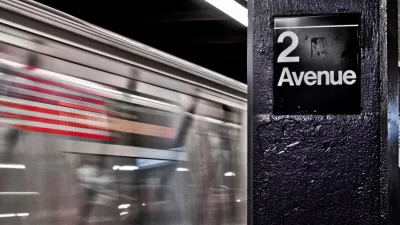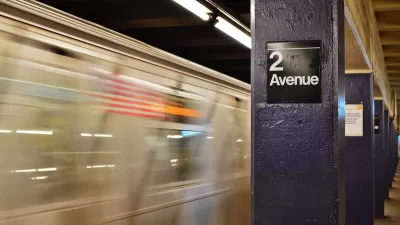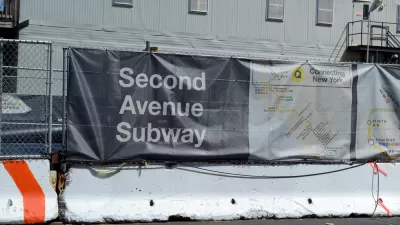In an article and dramatic photographs and video, The New York Times documents the construction of the city's Second Avenue subway, which has been delayed for more than 80 years and is due to be completed in December 2016.
First announced in 1929, the subway is planned to eventually run from the Financial District, at Manhattan's southern tip, up to 125th street, along Second Avenue.
Working 24 hours a day since 2008, in a process that works much differently now than it did when the first subway was built in 1900, "about 475 laborers are now removing 15 million cubic feet of rock and 6
million cubic feet of soil - more than half an Empire State Building by
volume - out from under two miles of metropolisr," writes Kim Tingley. For all the modern technology, however, "There is still no way to mine a tunnel without sending men into it."
"Underground, they breathe chemical fumes and dust, no matter how well
filtered the air. Water and mud splash up and rain down. They yell
themselves hoarse over the rumbling of machines and don't always wear
earplugs against the din. 'I think the biggest thing I'm sacrificing is
my health,' [sandhog Ryan] McGinty said. 'But for me to do something I love and be
proud of what I do - If I made it to 60, I'd be happy.'"
"The president of M.T.A. Capital Construction Company, Michael
Horodniceanu, has taken East Siders on Saturday cavern tours, in part to
make up for the blasting. 'They're all kind of in awe of what they're
seeing,' he said, 'because they understand that it's been created by
men. The question that I always get: ‘What was here before?' The answer
is, ‘Solid rock.' "
To get a sense of the awe-inspiring environment, check out the accompanying video and image gallery.
FULL STORY: Tunneling Below Second Avenue

Planetizen Federal Action Tracker
A weekly monitor of how Trump’s orders and actions are impacting planners and planning in America.

Maui's Vacation Rental Debate Turns Ugly
Verbal attacks, misinformation campaigns and fistfights plague a high-stakes debate to convert thousands of vacation rentals into long-term housing.

San Francisco Suspends Traffic Calming Amidst Record Deaths
Citing “a challenging fiscal landscape,” the city will cease the program on the heels of 42 traffic deaths, including 24 pedestrians.

Amtrak Rolls Out New Orleans to Alabama “Mardi Gras” Train
The new service will operate morning and evening departures between Mobile and New Orleans.

The Subversive Car-Free Guide to Trump's Great American Road Trip
Car-free ways to access Chicagoland’s best tourist attractions.

San Antonio and Austin are Fusing Into one Massive Megaregion
The region spanning the two central Texas cities is growing fast, posing challenges for local infrastructure and water supplies.
Urban Design for Planners 1: Software Tools
This six-course series explores essential urban design concepts using open source software and equips planners with the tools they need to participate fully in the urban design process.
Planning for Universal Design
Learn the tools for implementing Universal Design in planning regulations.
Heyer Gruel & Associates PA
JM Goldson LLC
Custer County Colorado
City of Camden Redevelopment Agency
City of Astoria
Transportation Research & Education Center (TREC) at Portland State University
Jefferson Parish Government
Camden Redevelopment Agency
City of Claremont





























